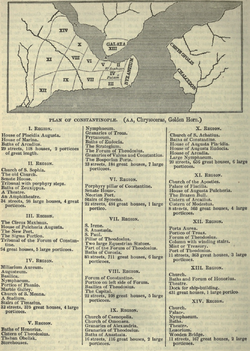Notitia Urbis Constantinopolitanae
- Notitia Urbis Constantinopolitanae
-

Map of the regions of the city according to the
Notitia, including the major buildings present in each of them.
The Notitia Urbis Constantinopolitanae is an ancient "regionary", i.e., a list of monuments, public buildings and civil officials in Constantinople during the mid-5th century (between 425 and the 440s), during the reign of the emperor Theodosius II. The text lists the fourteen regions in which Constantinople was divided, along with the major public buildings such as fora, theatres, churches, palaces, baths and pools. It also lists the number of "houses" (domus), although there is uncertainty over the exact meaning of the term. Finally, the list includes the civil officials of each region, including the curators, the heads of the associations (collegia) and the heads of neighbourhoods (vicomagistri).
The Latin text of the Notitia Urbis Constantinopolitanae was published by Otto Seeck, as an appendix to his edition of the Notitia Dignitatum (1876). The Notitia Urbis was probably written between 447 and 450 and goes back to official sources. Although the simple lists are not always easy to understand, the Notitia Urbis helps to know what the city must have looked like before Justinian's building program.
External links
Categories:
- 5th century in the Byzantine Empire
- Latin prose texts
- Constantinople
- 5th-century works
Wikimedia Foundation.
2010.
Look at other dictionaries:
Notitia urbis Constantinopolitanae — The Notitia Urbis Constantinopolitanae is an ancient regionary , i.e., a list of monuments, public buildings and civil officials in Constantinople during the mid 5th century (between 425 and the 440s), during the reign of the emperor Theodosius… … Wikipedia
Notitia urbis Constantinopolitanae — (лат.), описание на лат. яз. 14 областей и некоторых важнейших архитектурных сооружений Константинополя (храмов, дворцов, бань и т. д.). Составлено при Феодосии II (408–450). Рукописная традиция тесно связывает этот памятник с «Notitia… … Словарь античности
Notitia Dignitatum — Saltar a navegación, búsqueda Escudos del Magister Militum Praesentalis II. En este caso un página de la Notitia Dignitatum, una copia de los mandos militares del Imperio Romano de Occidente. La Notitia Dignitatum es un documento único d … Wikipedia Español
Notitia Dignitatum — • The official handbook of the civil and military officials in the later Roman Empire Catholic Encyclopedia. Kevin Knight. 2006. Notitia Dignitatum Notitia Dignitatum … Catholic encyclopedia
Notitia dignitatum — Seite aus der Notitia Dignitatum die Einheitsbezeichnung und Schildemblem der Truppen (Comitatenses) unter dem Kommando des magister equitum (OB der Kavallerie) darstellt. Die Notitia Dignitatum (ND) ist die Kopie eines mehrfach ergänzten… … Deutsch Wikipedia
Notitia Dignitatum — Seite aus der Notitia Dignitatum die Einheitsbezeichnung und Schildemblem der Truppen (Comitatenses) unter dem Kommando des mag equitum (OB der Kavallerie) darstellt … Deutsch Wikipedia
Notitia Dignitatum — Page from a medieval copy of the Notitia Dignitatum, depicting shields of Magister Militum Praesentalis II, a late Roman register of military commands. The Notitia Dignitatum is a unique document of the Roman imperial chanceries. One of the very… … Wikipedia
Notitia dignitatum — Página de una copia medieval de la Notitia dignitatum con los escudos del Magister Militum Praesentalis II, registro de los mandos militares del Imperio. La Notitia dignitatum es un documento único de la cancillería imperial romana. Se trata de… … Wikipedia Español
Walls of Constantinople — Istanbul, Turkey Map showing Constantinople and its walls du … Wikipedia
Comte de Lamia — Le Comte de Lamia ou Comte de la Lamia (en grec byzantin κόμης τῆς λαμίας / kómês tês lamías) est un fonctionnaire byzantin du Génikon chargé probablement du dernier grand grenier d État de Constantinople au IXe siècle, le successeur des… … Wikipédia en Français

